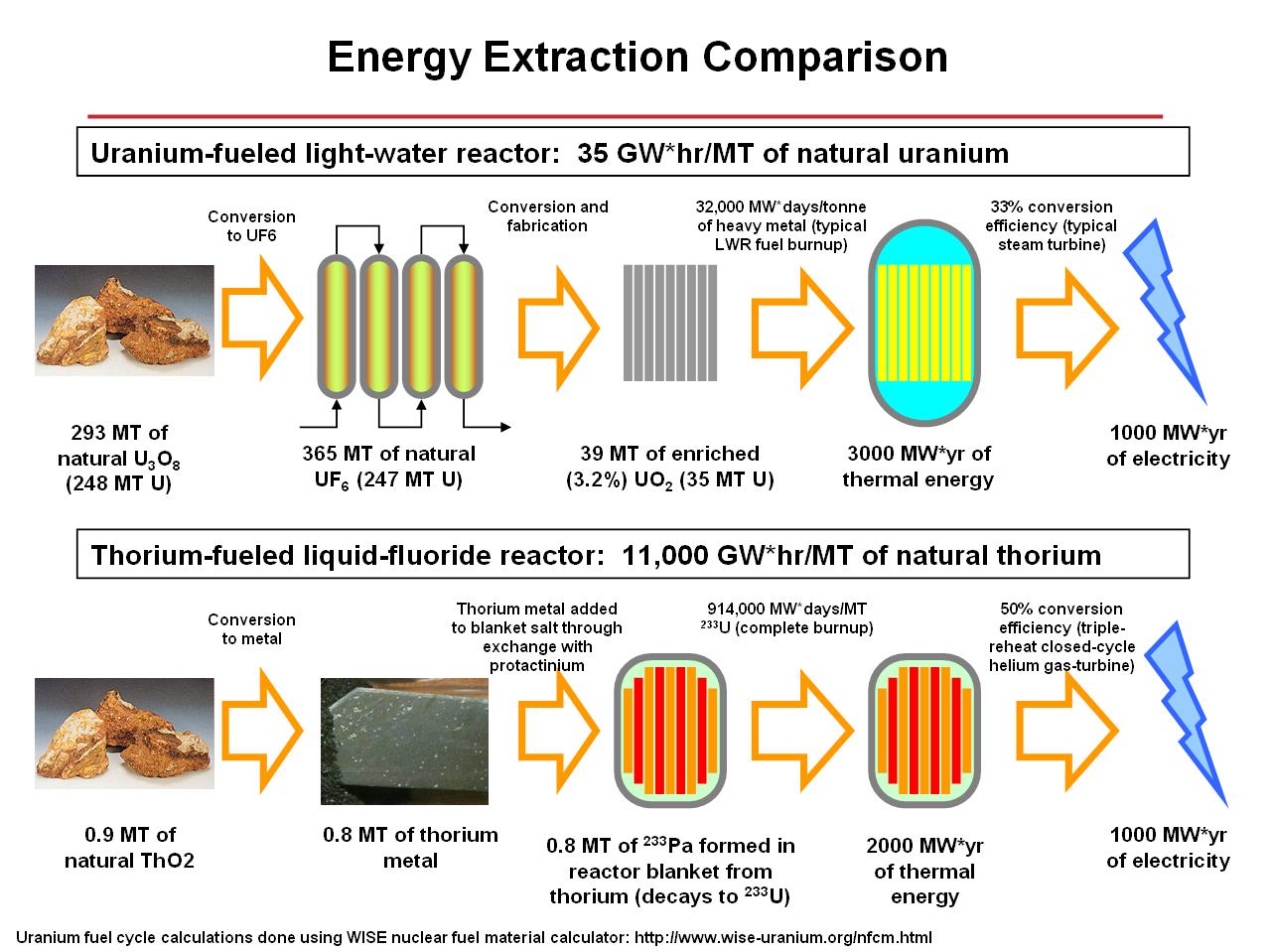Thorium reactors could be 5 times cheaper than natural gas energy, be meltdown resistant, be able to destroy old long lived radioactive waste, and involve no readily usable weapons grade material.
Thanks to Futurepundit for his article on this
The amount of energy per kg of thorium is huge: 11 million kW-hr per kg.
Besides having a lot of thorium on earth, a lot of thorium deposits have been detected on the moon Map of thorium lunar deposits Initially any lunar reactor would just bring thorium and other material from earth and get its mining and industrial production processes set up.
Wikipedia is less optimistic about thorium as a nuclear fuel
World nuclear associations view of Thorium reactors
Here is an article that calculates how much thorium it would take to power the world.
Here is an introduction to the thorium fuel cycle
A Thorium nuclear reactor will eliminate weapons grade plutonium and other radiative waste as part of the power-generation process. A uranium-fuelled reactor might generate a tonne of high-level waste that stays toxic for tens of thousands of years. A reactor fuelled only by thorium will generate a fraction of this amount. And it would stay radioactive for only 500 years – after which it would be as manageable as coal ash. The main drawback to thorium is that it’s not vigorously fissile, and it needs a source of neutrons to kick off the reaction.
The main stumbling block until now has been how to provide thorium fuel with enough neutrons to keep the reaction going, and do so in an efficient and economical way.
In recent years two new technologies have been developed to do just this.
One company that has already begun developing thorium-fuelled nuclear power is Thorium Power, based just outside Washington DC. The way Thorium Power gets around the sub-criticality of thorium is to create mixed fuels using a combination of enriched uranium, plutonium and thorium.
At the centre of the fuel rod is the ‘seed’ for the reaction, which contains plutonium.
Wrapped around the core is the ‘blanket’, which is made from a mixture of uranium and thorium. The seed then provides the necessary neutrons to the blanket to kick-start the thorium fuel cycle. Meanwhile, the plutonium and uranium are also undergoing fission.
The primary benefit of Thorium Power’s system is that it can be used in existing nuclear plants with slight modification, such as Russian VVER-1000 reactors. Seth Grae, president and chief executive of Thorium Power, and his team are actively working with the Russians to develop a commercial product by the end of this decade. They already have thorium fuel running in the IR-8 research reactor at the Kurchatov Institute in Moscow.
“In the first quarter of 2008, we expect to have lead test assemblies in a full-size commercial nuclear power plant in Russia,” said Grae.
AN ALTERNATIVE DESIGN does away with the requirements for uranium or plutonium altogether, and relies on thorium as its primary fuel source. This design, which was originally dubbed an Energy Amplifier but has more recently been named an Accelerator Driven System (ADS), was proposed by Italian Nobel physics laureate Carlos Rubbia, a former director of one of the world’s leading nuclear physics labs, CERN, the European Organisation for Nuclear Research.
An ADS reactor is sub-critical, which means it needs help to get the thorium to react. To do this, a particle accelerator fires protons at a lead target. When struck by high-energy protons the lead, called a spallation target, releases neutrons that collide with nuclei in the thorium fuel, which begins the fuel cycle that ends in the fission of U-233.
A nuclear reactor that requires a particle beam to keep it running might seem a bit strange. But on the contrary, this is one of the ADS design’s most attractive features. If the particle beam is switched off, it is impossible for the fuel to enter a chain reaction and cause a meltdown. Instead, the rate of fission will immediately begin to slow and the fuel will eventually cool down and die out. According to Sydney’s Hashemi-Nezhad, a sub-critical reactor such as this has clear safety benefits over uranium reactors. “It has zero chance of a Chernobyl-type accident,” he said.
Another major advantage of this design is that it only requires thorium as fuel.
Hashemi-Nezhad also says thorium is a highly abundant resource “550 times more abundant in nature than uranium-235”.
CERN recently released a detailed report covering the financial viability of the ADS design for power generation, and found it to be at least three times cheaper than coal and 4.8 times cheaper than natural gas. Any nuclear reactor will have a high establishment cost, but CERN stresses that a long-life reactor will be highly competitive compared to fossil and renewable energy fuels.
Another approach is a Liquid-Fluoride Thorium Reactor


Brian Wang is a Futurist Thought Leader and a popular Science blogger with 1 million readers per month. His blog Nextbigfuture.com is ranked #1 Science News Blog. It covers many disruptive technology and trends including Space, Robotics, Artificial Intelligence, Medicine, Anti-aging Biotechnology, and Nanotechnology.
Known for identifying cutting edge technologies, he is currently a Co-Founder of a startup and fundraiser for high potential early-stage companies. He is the Head of Research for Allocations for deep technology investments and an Angel Investor at Space Angels.
A frequent speaker at corporations, he has been a TEDx speaker, a Singularity University speaker and guest at numerous interviews for radio and podcasts. He is open to public speaking and advising engagements.

